TAXING AND SPENDING
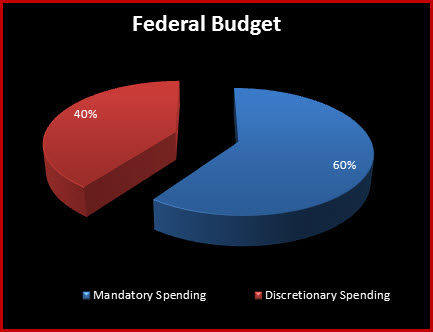
Unit
Overview
Although
no one likes to pay them, taxes are necessary because they generate the money
to fund the goods and services that Americans have come to expect from their
government. National defense, education,
highways, help for people in need and law enforcement are just a few things
that our tax dollars provide. Like
households, the President and Congress share the responsibility for preparing a
budget to allocate the nation's financial resources. This involves planning, analysis and, like
all economic decisions, trade-offs. Let's
see how it all happens.
The
Power to Tax
To
acquire the money that they need to operate, governments require citizens to
pay taxes. Income from taxes and other non-tax sources,
such as loans or government-owned enterprises, is called revenue. Without revenue,
government would not be able to provide the services that Americans have come
to expect. These include national
defense, education, infrastructure and help for those in need. The Founding Fathers intensely debated the
wisdom of giving the federal government the authority to tax. For this reason, the Constitution sets very
specific limits on this power. It cannot
be used to collect money that goes to individual interests, and federal taxes
must be the same in every state. The
Constitution also prohibits certain types of taxes. For example, since it violates the freedom of
religion guaranteed by the First Amendment, Congress cannot tax church
services. The Constitution, however, can
also be amended. In 1913, the Sixteenth Amendment legalized the
collection of federal income tax, which had been declared unconstitutional by
the Supreme Court.

Although
no one really wants to pay taxes, we will always need them. For this reason, it is important that taxes
be equitable, reasonably simple to understand and easy to collect. Citizens and businesses should be able to
prepare their own tax forms and to pay what they owe on a regular
schedule. At the same time, government
officials need to collect taxes without spending too much time and money. A tax must generate enough revenue to make
the process worthwhile. Tax payers want
a system that is fair and avoids loopholes.
These are exceptions that permit some people to pay less than others.
![]() Go to Questions 1
and 2.
Go to Questions 1
and 2.
Tax
Structures
When
adding new taxes, federal, state and local governments make two important
decisions: exactly what is going to be taxed
and how the tax is going to be structured.
The property, income, good or service that is taxed is referred to as
the tax base. After establishing a tax
base, governments must then choose the best way to structure the tax. Economists divide tax structures into three
categories: proportional, progressive
and regressive. As with all decisions,
each tax structure comes with benefits and trade-offs.
A proportional tax, sometimes called a flat tax, requires everyone to pay the
same percentage regardless of their income.
The more money an individual makes, the more he or she pays in
proportional tax. For example, aside from federal income tax, some towns and
cities also collect local income taxes from their residents. Unlike federal income tax, everyone usually
pays the same percentage. Based on a tax
rate of 2%, an architect with an income of $125,000 annually pays $2500. A nurse's aide, who earns $30,000 a year,
also pays 2% for a total of $600. Proportional
taxes have several advantages. They are
simple to understand and easy to collect.
On the other hand, opponents argue that proportional taxes are unfair
because they demand more sacrifices from lower-income households that already
spend most of their earnings on necessities.
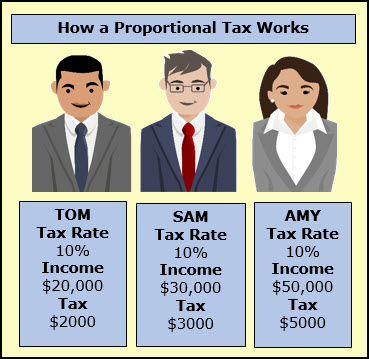
Because
it is based on a percentage that may increase or decrease depending on changes
in income, a progressive tax
structure is more complicated than a proportional system and requires the
supervision of government agencies, such as the Internal Revenue Service. At
the same time, progressive taxes generally produce the most revenue. Federal income tax is one example of a
progressively structured tax. Under this
system, people with large incomes pay more, while those with small incomes pay
little or nothing. The federal income
tax code consists of several levels called brackets. A tax payer may pay several different rates
depending on his or her earnings. In
other words, the government divides taxable incomes into pieces, and each piece
is taxed at a corresponding rate.
Let's
see how it all works by looking at a single taxpayer. Allen is an electrical technician and earns $53,000
annually. At first glance, you may think
that Allen simply has to pay 25% of $53,000.
Fortunately for our taxpayer, this is not the case. Allen pays 10% on $9,275 of his
earnings. Moving to the next bracket, he
owes 15% of $28,375. This leaves $15,350
for the third bracket at 25%. The
graphic below illustrates Allen's tax calculations.
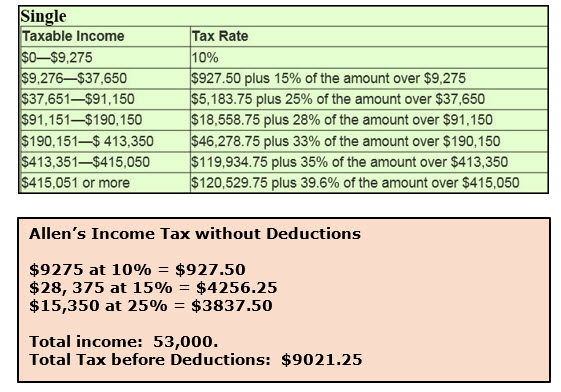
Governments
also add to their revenue by collecting taxes based on the regressive structure. Under a regressive
tax, the percentage of income paid in taxes goes down when income
increases. This format is often
criticized because it imposes a greater burden on low-income households. State sales tax qualifies as a regressive tax. Let's say someone who earns $20,000 annually spends
$7,200 on clothing and food. At the same
time, a person making $200,000 spends $20,000 on the same essentials. If the state sales tax is 5%, the individual
earning $20,000 spends almost 2% of his or her annual income on state sales
tax. Although the person earning
$200,000 spends more money on food and clothing, the state sales tax on these
items adds up to .5% of his or her total income. For this reason, opponents of the regressive
tax structure argue that these taxes are unfair. At the same time, they are easy to understand
and simple to collect. Therefore, they
continue to be a valuable source of revenue.
![]() Go to Questions 3
through 8.
Go to Questions 3
through 8.
Collecting
Taxes
The
federal government has several major sources of tax revenue. You can see how they contribute to the
nation's financial status in the table below.
Although the goal of taxes is to create operating money, sometimes the
federal government also uses them to discourage the public from buying harmful
products. Federal taxes on tobacco and
alcohol, often referred to as sin taxes,
fall into this category. In these
cases, taxes not only provide money for goods and services but also serve as
incentives to change behavior.
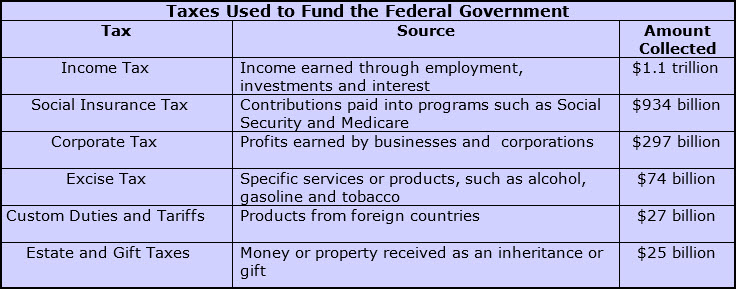
Individual
income taxes are currently the country's main source of revenue. Because the amount that each person owes is
determined annually, the government could collect this tax in one lump sum at
the end of the year. It is likely,
however, that this would create problems for taxpayers and government. A single, annual payment from everyone at
once would make it difficult for the government to cover expenses, such as
rent, salaries, supplies and services, throughout the year. Taxpayers, too, might have trouble budgeting
the money for one, large tax bill. For
these reasons, employers are responsible for collecting taxes on a pay-as-you-earn
system.
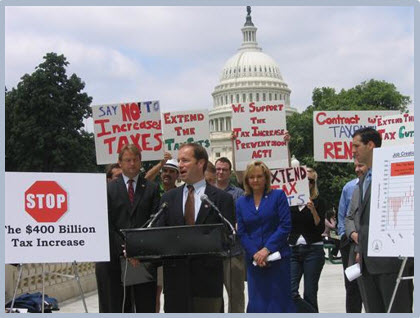
Rally to Protest a
Tax Increase
Under
the pay-as-you-earn system,
employers withhold, or take out,
payments from workers' salaries before they receive them. Then, they forward this money to the federal
government. At the end of the year,
every employee receives a W-2 form
from his or her employer. This report
shows the total amount of income tax paid during the year. Workers use this information to complete tax
return forms that determine whether the amount withheld covers the tax
owed. If the total collected by the
employer is lower than the actual amount due, the worker pays the difference. On the other hand, if the total collected by
the employer is higher than the actual amount due, the worker receives a refund
from the federal government. Midnight on
April 15 (or the first business day
after April 15) is the deadline for submitting tax returns for the previous
year to the Internal Revenue Service (IRS).
In
addition to income taxes, employers also deduct funds for Social Security and
Medicare, two well-known federal programs.
Social Security, launched in
1935 in response to hardships encountered during the Great Depression, was
established as a retirement fund that provided pensions for older
Americans. Today, the fund also pays
benefits to disabled workers and the surviving family members of wage
earners. Medicare is the country's national health insurance program. It helps people over sixty-five pay for
hospital care and medical services. It
also assists people who suffer from certain diseases and disabilities.
![]() Go to Questions 9
through 13.
Go to Questions 9
through 13.
Setting
up the Federal Budget
Just
as households plan the best way to utilize their financial resources, Congress
and the President share the responsibility for establishing the federal budget. This plan lists the nation's expected income
and shows exactly how the money will be spent.
The federal government prepares a new budget for each fiscal year. A fiscal
year is a twelve-month period that does not necessarily follow the
traditional January-through-December format.
Usually, the federal government's fiscal year runs from October 1
through September 30.
The
process begins with the offices and agencies funded by the federal
government. Each one prepares a detailed
estimate of the money needed to operate during the upcoming fiscal year. The Office
of Management and Budget (OMB), an
agency within the executive branch, reviews these proposals and works with the
President's staff to combine them into a single document. The President presents this spending plan to
Congress in January or February. At this point, the budget is nothing more than
a request. Congress must approve the
funds to make it a reality.
For
the next few months, Congress studies, debates and modifies the President's
proposed budget. Committees in the House
of Representatives and the Senate hold hearings and listen as agency officials
explain their funding requests. The Congressional Budget Office (CBO)
assists in the process by collecting additional statistics concerning the
economy. Before the end of the fiscal
year, Congress must pass the revised budget and a series of appropriation, or
spending, bills to pay for it. Once the President signs the appropriation bills, the budget becomes
the official spending plan for the new fiscal year beginning on October 1. The President also has the option of vetoing
these bills.
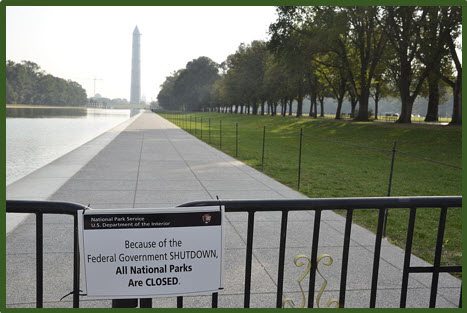
Shutdown
Barricades at the Washington Monument:
2013
If
the budget is not finalized by September 30, Congress approves stop-gap funding. This emergency legislation keeps the
government running temporarily. If the
President refuses to sign this measure, the government stops functioning. For example, in 2013, the government
experienced a sixteen-day shutdown. For over two weeks, only essential
services, such as the military, remained operational. The news clips listed below describe the
events leading up to the federal shutdown. Nearly 800,000 federal employees experienced
lay-offs; others were required to report for work but did not know when they
would receive their next paychecks.
National parks and monuments closed, and some benefit payments were
delayed. Congress and President Obama
eventually reached a compromise and agreed on a new bill to end the crisis.
![]() Go to Questions 14 through 16.
Go to Questions 14 through 16.
Where
Does All the Money Go?
Federal
spending is divided into two major categories, mandatory spending and
discretionary spending. Mandatory spending consists of payments
that the government is required by law to make.
Along with interest fees on the national debt, this category includes a
number of entitlement programs, such as Social Security, Medicare, Medicaid and
the Supplemental Nutritional Assistance Program (SNAP). Entitlement
programs pay benefits to U.S. citizens who meet certain eligibility
requirements established by law. In other words, people qualify for, or are
entitled to, these benefits because they meet certain legal standards. Unlike
other areas of the federal budget, Congress does not annually approve dollar
amounts to fund these programs. It may, however, pass new legislation that
changes eligibility criteria or benefit formulas.
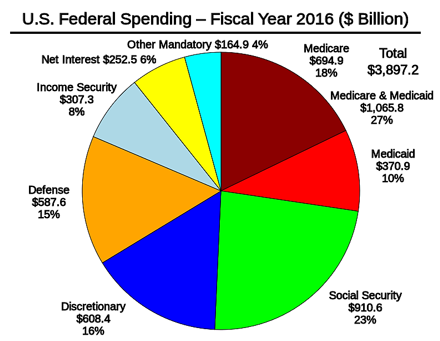
The
remaining items in the federal budget make up what is known as discretionary spending. Discretionary spending covers defense,
education, student loans, scientific research, national parks, disasters aid
and many other federal programs. To fund
these areas of the budget, Congress passes appropriation bills with specific
dollar amounts attached. This means that
Congress must make choices that result in trade-offs. Before the Great Depression, almost all
government spending was discretionary.
However, the creation of Social Security in 1935 and Medicare in 1965
changed how the federal government spent its money. Today, almost 70% of the federal budget is
devoted to mandatory spending. The graph
below shows the changes in mandatory and discretionary spending over the course
of several decades.
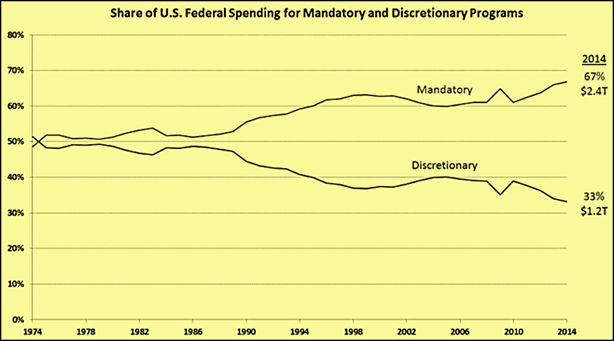
![]() Go to Questions 17
through 19.
Go to Questions 17
through 19.
Deficit
and Surplus
When
federal spending equals federal revenue for a given fiscal year, the
government's budget is balanced. The same amount of money is flowing into the
Treasury as is flowing out of the Treasury.
In reality, this almost never happens.
Most of the time, the government operates at a deficit or a
surplus. When a fiscal year's revenue is
greater than its expenses, a budget
surplus occurs. During the
mid-1990s, tax increases, a strong economy and low unemployment resulted in
several fiscal years of surpluses. These
favorable circumstances did not last long.
The stock market boom ended, tax cuts reduced the amount of money
collected and terrorist attacks on September 11, 2001 disrupted the
economy. All of these factors added up
to a series of fiscal years with budget deficits.
A budget deficit is the result of the
government spending more than it takes in. In this situation, printing more money is an
option, but this causes inflation and lowers the value of the country's
currency. Therefore, the government
usually chooses to borrow the money to make up the shortfall. This action has its advantages. Borrowing money permits the government to
undertake projects it could not otherwise afford. It also allows government to produce more
goods and services. Unfortunately, each
fiscal year of budget deficits increases the total amount of money owed. This accumulates and grows into what is
called the national debt. The video listed
below explains the history of the national debt. It also discusses its pros and cons.
![]() The Historic Struggle with the National Debt
The Historic Struggle with the National Debt
![]() Go to Questions 20
through 22.
Go to Questions 20
through 22.
What's
next?
When
planning the federal budget, Congress and the President deal with the basic
economic problem of allocating scarce resources. Countries, like individuals, cannot produce
all the goods and services they need or want.
One way that nations deal with this problem is through trade. Is it cheaper for a country to import certain
products rather than manufacture them?
Should a country specialize in a few goods that it can export at a
profit? Before moving on to answer these
questions in the next unit, review the terms found in Unit 14; then, answer
Questions 23 through 32.
![]() Go to Questions 23
through 32.
Go to Questions 23
through 32.
 |
| Unit 14 Main Points Worksheet |
| Unit 14 Budget cuts put vital U.S. flood warning system at risk Article and Quiz |
| Unit 14 Taxes |